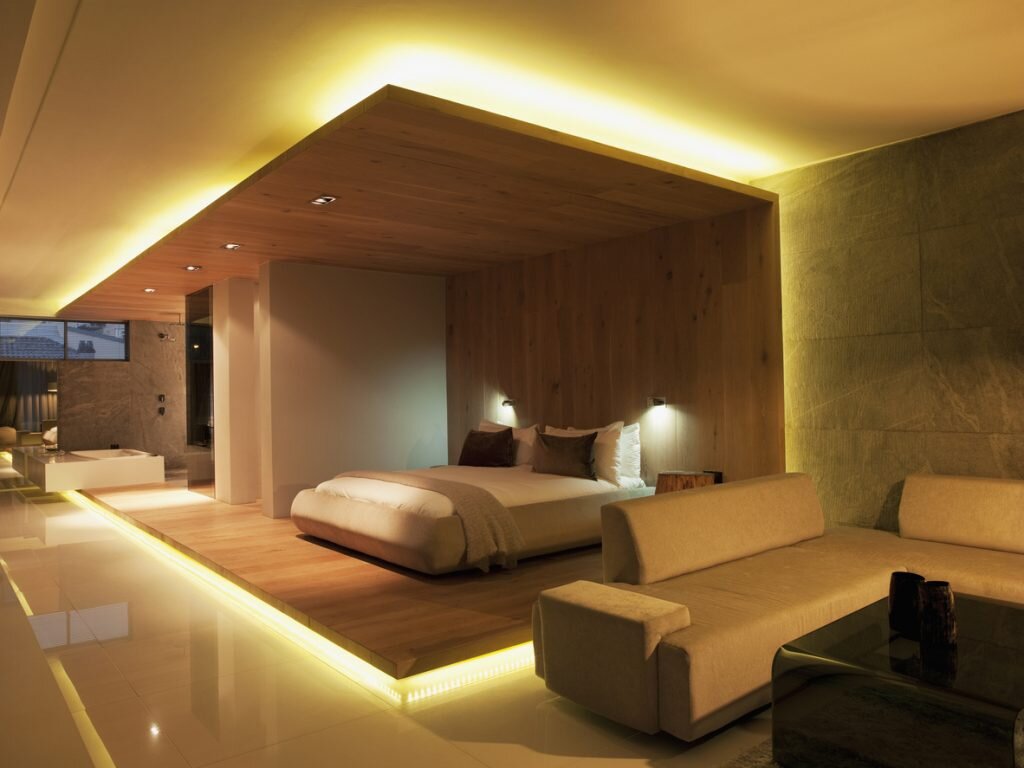Are you planning to build a new house or renovate your home from the ground up? Then you should start planning the lighting for your home early enough. What advances have been made in lighting technology? Which lighting systems should be integrated? And what options are there in terms of lighting design? These are the questions you should ask yourself for an optimal lighting concept. We give you 5 tips on what is important in a good lighting concept.
Here you can find out how to go about planning the lighting for a house and what intelligent lighting systems are good for.


1. Lighting Design - Where Should Light Fixures be Installed?
Together with a lighting expert, get an overview of what kind of lighting is to be used in each room. If you want to install ceiling spots or recessed floor lighting, for example, the tradesmen need to know where to leave architectural recesses in the ceiling panelling or floor coverings. Subsequent alterations are not only tedious but also costly.
2. How Many Lights are to be Installed in the Room in Total?
A central part of the lighting design in a house is the question of how many light sources are ultimately to illuminate the room. In addition to the ceiling light, should a reading lamp or wall lamp also be installed in the living room? And what about recessed cupboard light systems or furniture lights? It is important to get an idea of the exact number of lamps so that the sockets and power outlets can be suitably arranged. Often, less importance is attached to this aspect of lighting planning than to the lighting design in the final phase of house construction. In the end, however, you will only be annoyed if the next free socket is at the other end of the room and you have to help yourself out with multiple sockets and cable extensions.
3. Plan the Lighting Mood
Do you want cosy light in the living room, but bright light in the bathroom or kitchen for make-up and cooking? To create the right lighting mood, it is essential to choose the right light source. Warm white light consists of yellowish nuances and creates cosiness and a sense of well-being. Warm white light sources are well suited for the living room or bedroom. For the kitchen or dining room, many prefer neutral white or daylight white light sources. You can find out more about this in our article on "Light Colours". You should think in advance about the areas of the house in which you want to create certain moods.
4. Use Indirect and Direct Lighting
For a perfect interplay of different light sources in a room, it is advisable to use both direct lighting and indirect lighting. Direct lighting is where lamps emit light directly to where it is needed; indirect lighting, on the other hand, is created by uplighter or wall lamps, for example, where light is reflected from the ceiling or wall. Would you like to know more about this? Click here for the article on "Direct and Indirect Lighting".
Instead of direct and indirect lighting, the types of lighting can also be divided into Ambient lighting, task lighting and Accent lighting. In our opinion, a room has its most harmonious effect when all three lighting elements are used. Ambient lighting refers to uniform light that helps people find their way around the room. Typical examples are hallway lighting or staircase lighting.
In addition to ambient lighting, we recommend using task lighting. This light illuminates and accentuates specific areas in the room. In the form of spotlights or pendant lamps, dining tables or reading corners, for example, can be put in the right light.
The icing on the cake when it comes to lighting is the mood or accent lighting that you achieve with carefully placed table lamps or recessed spotlights. This includes, for example, lights that are switched on only when needed, such as when dusk falls, and create a cosy, feel-good atmosphere in the room.

A small tip for all those who want to use cove lighting and indirect light: Projecting ceilings or walls are ideal for indirect lighting because you can easily hide ballasts and cables in the cavities. They create a pleasant lighting atmosphere and are easy to implement with early planning.
5. Think About Intelligent Lighting Management Systems and Smart Lights
Dimmable, day-dependent lighting controls, time switches or indoor lights with motion detectors: The possibilities in the field of lighting are becoming increasingly diverse - and can also be implemented relatively easily with the right lighting design. Before starting construction, think about whether you want to connect some lights in series and whether lighting with Smart Home lamps is an option for you. Because app-controlled lighting and intelligent lamp circuits can also work great and ensure that you save on energy costs.
Use light as a tool to design interiors according to your ideas and support the effect of the architecture and furnishings in the home through the use of lighting technology. We assure you: You will not regret a good lighting design.

